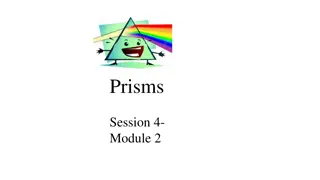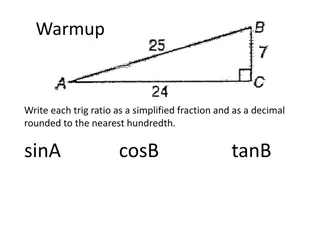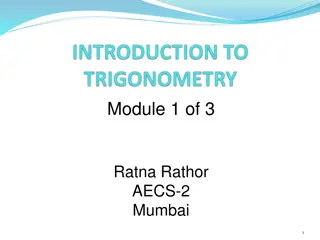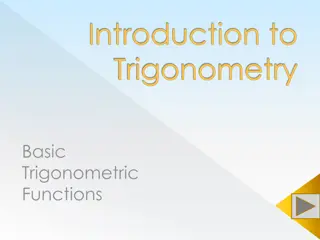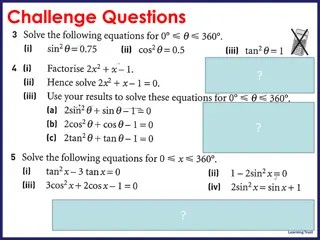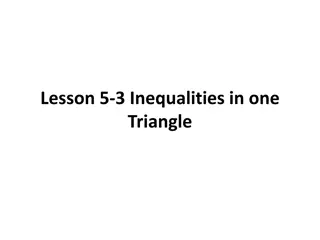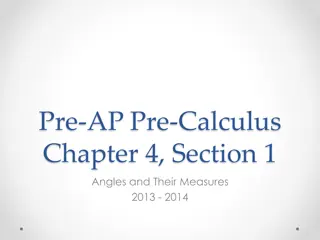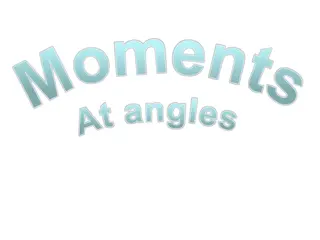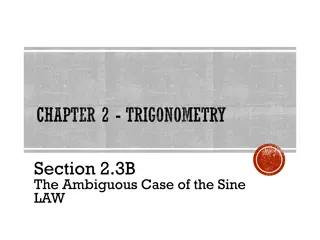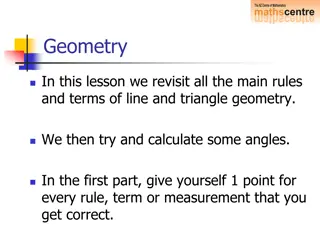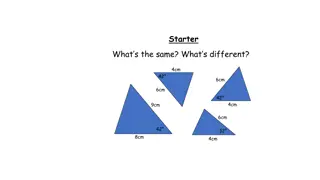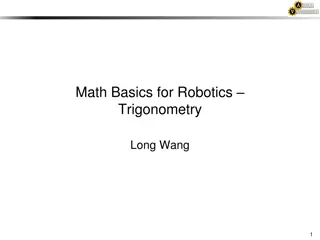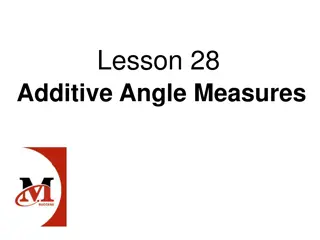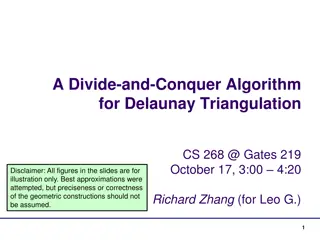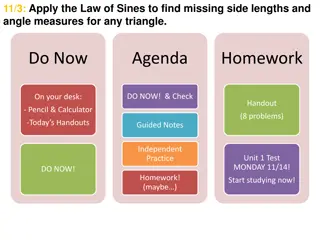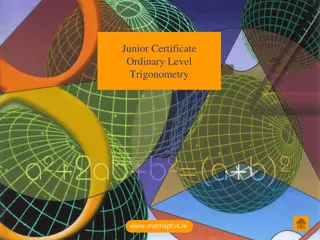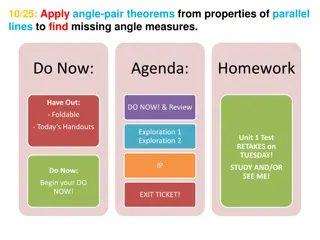Trigonometry Essentials: Missing Edges, Angle Calculations & Triangle Identification
Explore a comprehensive guide on trigonometry covering calculating missing lengths, determining angles, labeling sides of triangles, and solving problems using trigonometry. Learn about hypotenuse, opposite side, adjacent side, and practical applications through examples and visual aids.
Download Presentation

Please find below an Image/Link to download the presentation.
The content on the website is provided AS IS for your information and personal use only. It may not be sold, licensed, or shared on other websites without obtaining consent from the author.If you encounter any issues during the download, it is possible that the publisher has removed the file from their server.
You are allowed to download the files provided on this website for personal or commercial use, subject to the condition that they are used lawfully. All files are the property of their respective owners.
The content on the website is provided AS IS for your information and personal use only. It may not be sold, licensed, or shared on other websites without obtaining consent from the author.
E N D
Presentation Transcript
Find the missing edges (correct to 1 decimal place) a 6cm b 5cm 4cm 9cm 16cm 11cm d 1cm 1cm c
Answers 7.2cm 6cm 10.3cm 5cm 4cm 9cm 16cm 11cm 1.4cm 1cm 1cm 11.6cm
We can label the sides of a right-angled triangle in the following way: Hypotenuse (H) This is the longest side and is opposite the right- angle Opposite Side (O) This is the side opposite the angle in question Adjacent Side (A) This is the side adjacent (next to) the angle in question.
Label the sides of the right-angled triangles on the sheet.
dustonschoolmaths does trigonometry http://www.youtube.com/ watch?v=XyCdqyPFP50
Calculate the length of side p. A Hyp p C H 46 p = adj cos p = 7 cos 46 p = 10.08 cm 7cm Adj
Calculate the size of angle Q. O T A 4.3m Opp tan Q = opp adj tan Q = 4.3 3.8 Q = tan-1 (4.3 3.8) Q = 49 Q 3.8m Adj
Answers 1. a = 12.03 cm b = 61.44 cm c = 41.80 cm d = 115.19 cm 3. 2.25 m 4. 48.2o 5. 9.21 m 2. a = 69.5 b = 33.5 c = 69.4 d = 54.4 Extension: 12.073 cm (3dp)
Show me and example of: - A hypotenuse - An opposite side - An adjacent side - A problem that can be solved using trigonometry - A triangle in which the tangent of the angle is 1 - A triangle in which the cosine is 0.5
What is the same/different about three triangles with sides 3, 4, 5 and 6, 8, 10 and 5, 12, 13 True/Never/Sometimes: - You can use trigonometry to find the missing length/angle in triangles
The image below is of a cuboid. Calculate the size of the angle between CE and EFGH. C EG = EH + HG = 4 + 3 = 25 EG = 25 = 5 cm B C D A 11cm 11cm G 3cm F ? E E G H ? cm 4cm
The image below is of a cuboid. Calculate the size of the angle between CE and EFGH. C B C D A O T A 11cm 11cm Opp tan ? = opp adj tan ? = 11 5 ? = tan-1 (11 5) ? = 66 G 3cm F ? E E G H 5 cm Adj 4cm
Answers 1. 10.2 2. a. 9.11 cm b. 19.2
Starter Find the lengths of the missing sides. Give your answer in surd form where appropriate. 14 cm 2 33 _____ cm 4 cm 6 ___ cm 8 cm 5 cm 4 5 ____ cm 4 cm 16 cm
Make sure you fill in your table as we go you ll need it later! Angle ( Degrees) 0 30 45 60 90 180 270 360 sin cos tan
Periodic Symmetrical
Periodic Symmetrical
Remember: (You may want to copy these down!) O A O H H A sin cos tan
Lets start with an isosceles right-angled triangle with equal sides of 1 cm. These angles are equal and angles in a triangle sum to 180 . 45 1 cm 45 1 cm
Lets start with an isosceles right-angled triangle with equal sides of 1 cm. 45 2 cm 1 cm By Pythagoras Theorem, the hypotenuse is 2. 45 1 cm
sin 45 = _1_ 2 45 2 cm 1 cm 45 1 cm
sin 45 = _1_ 2 45 cos 45 = _1_ 2 2 cm 1 cm 45 1 cm
sin 45 = _1_ 2 45 cos 45 = _1_ 2 2 cm 1 cm tan 45 = 1 = 1 1 45 1 cm
sin 45 = 2 sin 45 = _1_ 2 2 45 cos 45 = 2 cos 45 = _1_ 2 2 2 cm 1 cm tan 45 = 1 = 1 1 45 1 cm Rationalising the denominators gives
Now lets look at an equilateral triangle with sides of 2 cm. 60 2 cm 2 cm 60 60 2 cm
Now lets look at an equilateral triangle with sides of 2 cm. By Pythagoras Theorem, the height is 3. 30 2 cm 3 cm 60 1 cm
sin 30 = 1 2 30 2 cm 3 cm 60 1 cm
sin 30 = 1 2 30 cos 30 = 3 2 2 cm 3 cm 60 1 cm
sin 30 = 1 2 30 cos 30 = 3 2 2 cm 3 cm tan 30 = _1_ 3 60 1 cm
Rationalising the denominator gives sin 30 = 1 2 30 cos 30 = 3 2 2 cm 3 cm tan 30 = _1_ 3 3 tan 30 = 3 60 1 cm
sin 60 = 3 2 30 2 cm 3 cm 60 1 cm
sin 60 = 3 2 30 cos 60 = 1 2 2 cm 3 cm 60 1 cm
sin 60 = 3 2 30 cos 60 = 1 2 2 cm 3 cm tan 60 = 3 1 60 1 cm
sin 60 = 3 2 30 cos 60 = 1 2 2 cm 3 cm tan 60 = 3 1 60 1 cm
Answers Question 1 a) d) - b) e) 1 2 c) f) -1 3 Question 2 a) 3 1 2 b) 3 Question 3 1 2 Question 4 a) 12 3 m b) 28 m Question 5 sin 270 sin 10 sin 135 sin 90
Trigonometry Help Flow Chart Is the triangle right-angled? Yes No Does the question involve any angles? Do you know a side and an opposite angle? Yes No No Yes Use Use trig ratios SOHCAHTOA Use the Cosine rule Use the Sine rule Pythagoras Theorem
Show me and example of: - A problem that can be solved using the sine rule - A problem that can be solved using the cosine rule - A triangle which you can find the area of
Group activity Put 3 triangles in each column to identify the method you would use to find the missing information. Make sure you can justify every triangle. Extension: How many can you solve?
Answers SOH CAH TOA ab sinC b x h Sine rule Cosine rule Pythagoras 1 6 2 5 3 9 13 8 4 10 7 11 15 17 14 16 12 18


